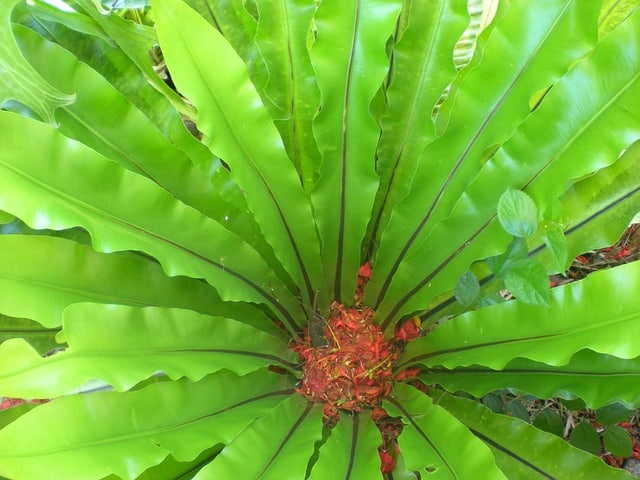Bird’s Nest Ferns are popular houseplants known for their unique and attractive fronds that resemble a bird’s nest. While these plants are relatively easy to care for, they can be susceptible to browning, which is a common issue that many plant owners face.
Understanding why a bird’s nest fern is turning brown is crucial in preventing further damage to the plant. Signs of a browning bird’s nest fern include brown tips, brown edges, and brown spots on the fronds. The causes of browning can range from overwatering, underwatering, exposure to direct sunlight, and pests.
Proper care for a bird’s nest fern includes watering the plant when the soil is dry, providing indirect sunlight, and fertilizing the plant every few months. Preventing browning in a bird’s nest fern involves maintaining a consistent watering schedule, providing adequate humidity, and ensuring the plant is not exposed to extreme temperatures.
By following these care tips, plant owners can help prevent their bird’s nest fern from turning brown.
Key Takeaways
- Understanding the signs of a browning bird’s nest fern is crucial in preventing further damage.
- Proper care for a bird’s nest fern includes watering, providing indirect sunlight, and fertilizing.
- Preventing browning in a bird’s nest fern involves maintaining a consistent watering schedule, providing humidity, and avoiding extreme temperatures.
See these other top posts in this category:
- Bird of Paradise Stems Turning Brown:
- Begonia Leaves Turning Brown on Edges:
- Bee Balm Leaves Turning Brown:
Understanding Bird’s Nest Fern
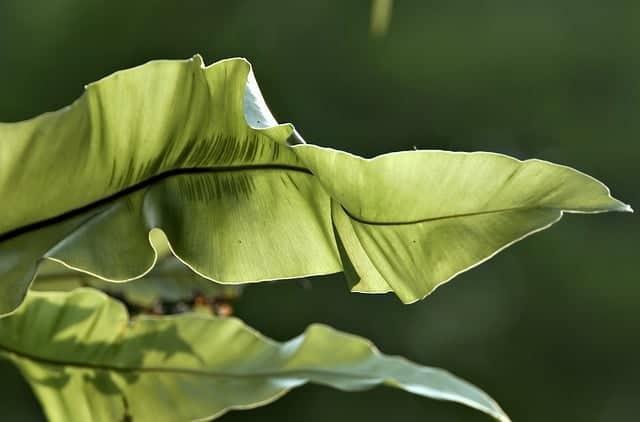
Bird’s Nest Fern (Asplenium nidus) is a popular houseplant that is native to Australia and Asia. It is an epiphytic plant that grows on trees in the tropical rainforest. The plant gets its name from the way the leaves grow in a rosette shape, resembling a bird’s nest.
The plant has shiny, bright green fronds that are wavy on the edges. It is a slow-growing plant that can live for several years if given proper care. The leaves of the plant can grow up to two feet long and eight inches wide.
Bird’s Nest Fern is an excellent plant for indoor gardening because it can survive in low light conditions. It is also a great air purifier, removing toxins from the air and improving indoor air quality.
However, the plant is susceptible to several issues that can cause the leaves to turn brown. Overwatering is one of the most common reasons for browning of the leaves. When the roots of the plant are soaked in water, they can rot and fail to take up enough oxygen, which can cause the leaves to turn brown.
Direct sunlight can also cause leaf scorch from too much sun exposure. The plant prefers bright, indirect light, and placing it in direct sunlight can cause the leaves to turn brown.
In addition to these issues, the plant can also be affected by pests and diseases, which can cause the leaves to turn brown. Pests like aphids, mealybugs, and scale can kill the plant if not treated promptly. Bacterial blight and crown rot are two common diseases that can cause the leaves to turn brown.
Signs of a Browning Bird’s Nest Fern
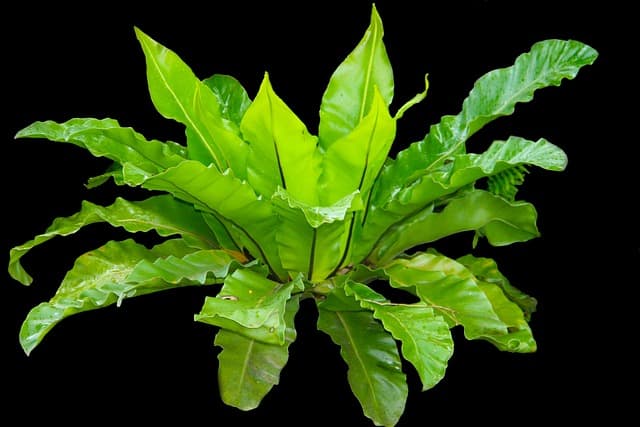
A Bird’s Nest Fern is a beautiful and popular houseplant that is known for its lush green leaves and unique rosette shape. However, if you notice your Bird’s Nest Fern turning brown, it could be a sign that something is wrong. Here are some signs to look out for:
- Brown spots on fronds: If you notice small brown spots on the fronds of your Bird’s Nest Fern, it could be a sign of bacterial or fungal leaf spot diseases. The most common is bacterial blight, which starts with small translucent spots that quickly turn reddish-brown.
- Browning tips: Brown tips on the fronds of a Bird’s Nest Fern can be caused by a variety of factors, including improper watering, low humidity, temperature stress, exposure to direct light, or the lack of it. Root rot and repotting shock can also lead to the same problem.
- Brown leaves: If the entire leaf of a Bird’s Nest Fern turns brown, it could be a sign of overwatering or underwatering. Overwatering can cause the roots to rot and fail to take up enough oxygen due to excess water sitting at the bottom of the container. Underwatering, on the other hand, can cause the leaves to dry out and turn brown.
- Yellow leaves: If the leaves of a Bird’s Nest Fern turn yellow, it could be a sign of nutrient deficiencies or pest infestations. Check the plant for pests like aphids, mealybugs, and scale as they can kill your Bird’s Nest Fern too.
- Wilting or drooping fronds: If the fronds of a Bird’s Nest Fern are wilting or drooping, it could be a sign of underwatering or overwatering. The plant may also be getting too much direct sunlight, which can cause leaf scorch from too much sun exposure.
- Rotten core or dying: If the center of the plant is browning, it could be a sign of crown rot, which is caused by overwatering or poor drainage. If the fronds have brown spots, it could be a sign of bacterial blight.
Bird’s Nest Fern Turning Brown – 7 Common Problems
Bird’s nest ferns are known for their lush green foliage, but when the leaves start turning brown, it can be a cause for concern. Here are some of the common causes of browning in bird’s nest ferns:
1. Light and Temperature Factors
Bird’s nest ferns thrive in indirect sunlight or filtered sunlight. Direct sunlight or exposure to hot temperatures can cause the leaves to scorch and turn brown. Cold drafts can also cause leaf tip burn. It is important to keep the plant in a location with consistent light and temperature conditions.
2. Watering Practices

Overwatering is a common cause of brown leaves on bird’s nest ferns. The excess water causes the roots to rot, which prevents them from taking up enough oxygen. Under watering or lack of water can also cause brown leaves.
It is important to water the plant consistently, but not too frequently. Using filtered water can also help prevent browning caused by chlorine or fluorine in tap water.
3. Soil and Drainage Issues
Bird’s nest ferns require well-draining soil and good drainage. Poor drainage or soggy soil can cause the roots to rot and lead to brown leaves. Checking the soil moisture with a moisture meter can help prevent overwatering or underwatering. Adding peat moss or moss to the soil can help retain moisture without causing drainage issues.
4. Humidity Conditions
Bird’s nest ferns prefer a moist environment with high humidity. Low humidity can cause the leaves to dry out and turn brown. Misting the leaves or using a humidifier can help maintain a moist environment. However, too much moisture can also cause brown leaves, so it is important to find the right balance.
5. Pests and Diseases
Bird’s nest ferns can be susceptible to pests such as scale, mealybugs, and foliar nematodes. These pests can cause brown spots on the leaves or damage the plant’s roots. Leaf spot disease and shore flies can also cause browning. Using insecticidal soaps or treating the plant with fungicides can help prevent these issues.
6. Fertilizer Problems
Overfertilization or using too much nitrogen can cause brown tips or edges on the leaves. It is important to follow the recommended fertilizer schedule and use a balanced fertilizer. Repotting the plant in a larger pot can also help prevent nutrient deficiencies.
7. Other Factors
Other factors that can cause browning in bird’s nest ferns include root-bound plants, exposure to drafts or cold temperatures, and the presence of spores or diseases. It is important to regularly inspect the plant for signs of issues and take appropriate measures to prevent browning.
Proper Care for Bird’s Nest Fern
Bird’s nest ferns are low-maintenance houseplants that can add a touch of tropical beauty to any indoor space. However, like any plant, they require proper care to thrive and avoid turning brown. Here are some tips for providing the best care for your bird’s nest fern:
1. Light
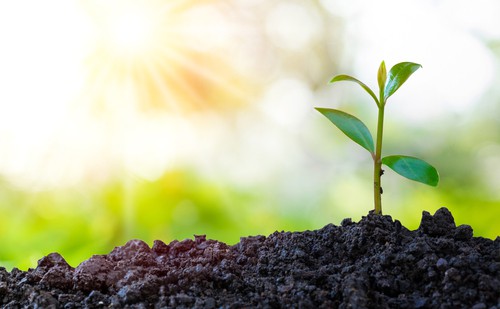
Bird’s nest ferns prefer bright, indirect light. Direct sunlight can scorch their leaves, while too little light can cause them to turn brown and wilt. If your fern is not getting enough light, consider moving it to a brighter location or supplementing it with artificial light.
2. Watering
Proper watering is crucial for the health of your bird’s nest fern. They prefer consistently moist soil, but not waterlogged. Overwatering can lead to root rot, while underwatering can cause the leaves to turn brown and dry out. Check the soil regularly and water when the top inch feels dry to the touch. Avoid letting the soil dry out completely.
3. Humidity
Bird’s nest ferns thrive in high humidity environments. Dry air can cause the leaves to turn brown and crispy. To increase humidity, consider using a humidifier, placing a tray of water near the plant, or misting the leaves regularly.
4. Soil
Bird’s nest ferns prefer well-draining soil that is rich in organic matter. Avoid using heavy soils that retain too much moisture, as this can lead to root rot. Consider adding perlite or sand to improve drainage.
5. Fertilizer
Bird’s nest ferns do not require frequent fertilization, but can benefit from a balanced, water-soluble fertilizer once every few months. Be sure to follow the instructions carefully and do not over-fertilize, as this can cause brown spots on the leaves.
Preventing Browning in Bird’s Nest Fern
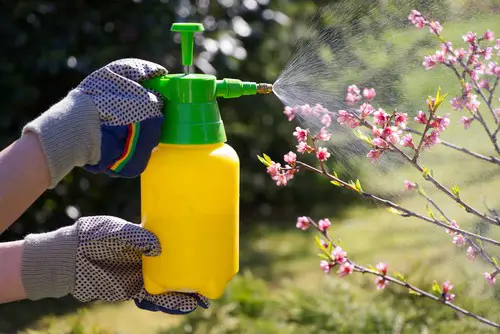
Browning in bird’s nest fern can be caused by a variety of factors, including lack of water, too much direct sunlight, low humidity, and pests. Fortunately, there are several steps that can be taken to prevent browning from occurring in the first place.
One of the most important things to keep in mind when caring for a bird’s nest fern is to avoid overwatering. While it’s important to keep the soil moist, it’s equally important not to let the plant sit in water. To prevent overwatering, make sure the pot has good drainage and only water the plant when the top inch of soil feels dry to the touch.
Trimming the plant can also help prevent browning. Regularly removing dead or damaged fronds can help the plant focus its energy on healthy growth. When trimming, use clean, sharp scissors or pruning shears to avoid damaging the plant.
Another way to prevent browning is to ensure that the plant is in a suitable environment. Bird’s nest ferns prefer bright, indirect light and high humidity. To increase humidity, consider placing a humidifier near the plant or placing a tray of water nearby.
Mold and bacterial blight can also contribute to browning in bird’s nest fern. To prevent these issues, make sure the plant is not overwatered and avoid getting water on the leaves. If you notice signs of mold or bacterial blight, treat the plant with a fungicide.
By following these tips, it’s possible to prevent browning in bird’s nest fern and keep the plant healthy and vibrant.
Frequently Asked Questions
How do you save a dying bird nest fern?
If your bird’s nest fern is dying, there are a few steps you can take to save it. First, check the soil moisture. Overwatering is a common cause of ferns dying, so make sure the soil is not waterlogged.
If it is, allow the soil to dry out before watering it again. Also, ensure that your fern is not exposed to direct sunlight or cold drafts. If the fronds are brown and dry, trim them off to encourage new growth.
What does an overwatered birds nest fern look like?
An overwatered bird’s nest fern will have brown, wilted fronds that are soft to the touch. The soil will be waterlogged, and there may be a foul odor coming from the pot. If left untreated, the roots will rot, and the plant will eventually die.
How do you treat brown spots on birds nest ferns?
Brown spots on bird’s nest ferns can be caused by a variety of factors, including fungal infections, bacterial infections, or insect infestations. To treat brown spots, first, remove any affected fronds and dispose of them. Then, apply a fungicide or insecticide to the plant according to the manufacturer’s instructions.
How do you fix brown leaves on ferns?
Brown leaves on ferns can be caused by a lack of water, too much direct sunlight, or exposure to cold drafts. To fix brown leaves, first, identify the cause of the problem and correct it. Then, trim off any brown leaves to encourage new growth. Be sure to water your fern regularly and keep it in a shaded area away from direct sunlight and cold drafts.
Why are my bird’s nest fern leaves turning brown?
Bird’s nest fern leaves can turn brown for several reasons, including overwatering, underwatering, exposure to direct sunlight, exposure to cold drafts, or nutrient deficiencies. To determine the cause of the problem, check the soil moisture, lighting conditions, and temperature. Then, take appropriate steps to correct the issue.
How much sun does a bird’s nest fern need?
Bird’s nest ferns prefer bright, indirect light but can tolerate some direct sunlight in the morning or evening. Avoid placing your fern in direct sunlight during the hottest part of the day, as this can scorch the fronds. Keep your fern in a shaded area away from cold drafts and extreme temperatures.

Hey, I’m Lisa and I’ve been an avid gardener for over 30 years. I love writing, talking and living in the garden! Feel free to connect with me on my socials below

